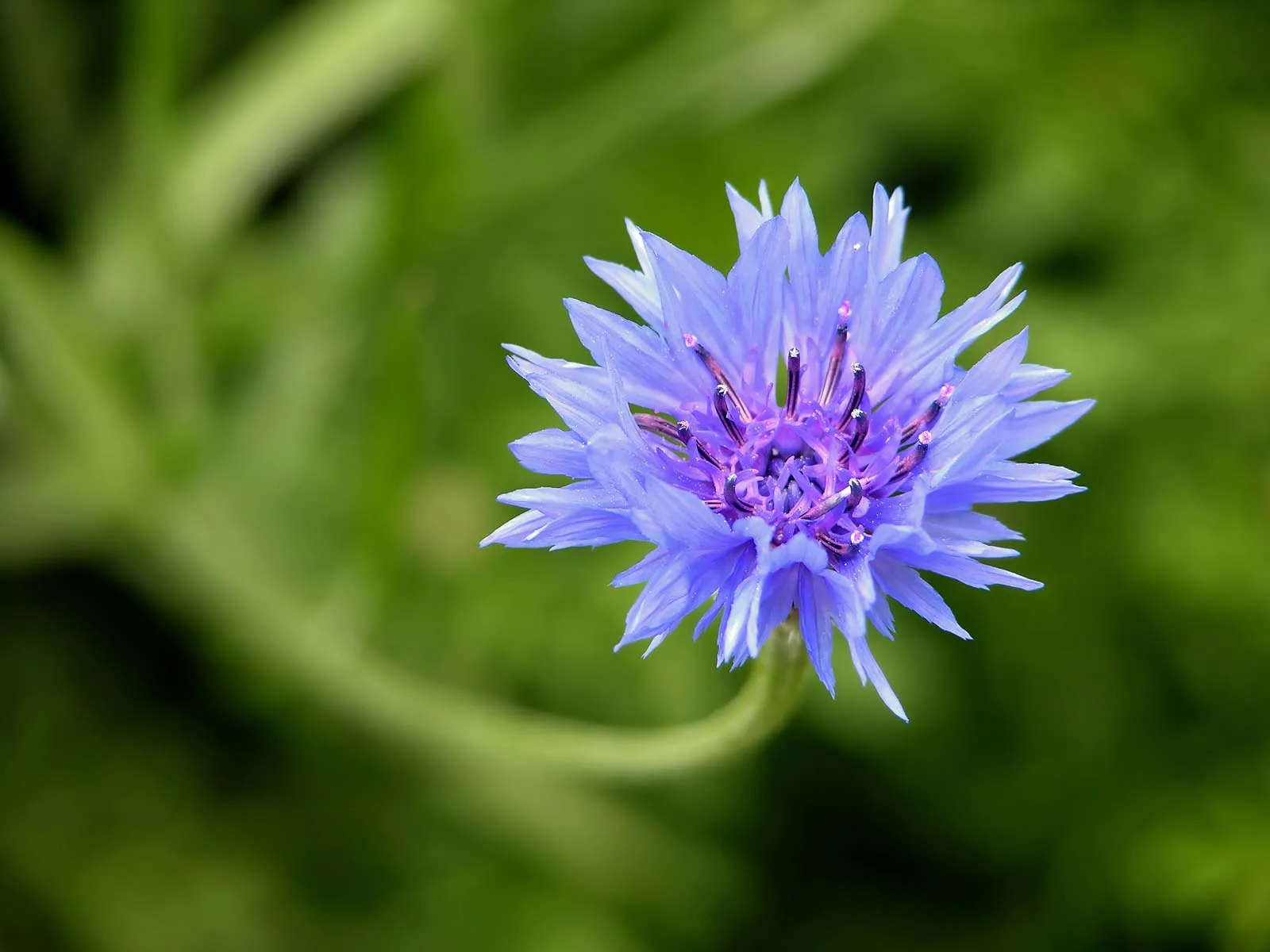
Cornflower, scientifically known as Centaurea cyanus, is a captivating flower that has been revered for centuries for its beauty and versatility. Its vibrant blue petals, delicate structure, and distinctive shape make it a popular choice for gardens, floral arrangements, and even herbal remedies. But there is much more to this fascinating flower than meets the eye.
In this article, we will explore 14 intriguing facts about cornflower that will not only deepen your appreciation for this remarkable plant but also expand your knowledge of its rich history and various uses. From its significance in folklore to its potential health benefits, cornflower continues to captivate and inspire people around the world. So, let’s delve into the enchanting world of cornflower and unravel its many secrets.
Key Takeaways:
- Cornflower, also known as Centaurea cyanus, is not only a symbol of love and romance but also has a rich history of medicinal uses, natural dyeing properties, and benefits for wildlife.
- Cornflower is a resilient and versatile plant with edible petals, anti-inflammatory properties, and cultural significance, making it a fascinating and valuable addition to gardens and natural habitats.
Symbol of Romance
Cornflower is known as the symbol of true love and romance. In Victorian times, couples exchanged cornflowers as a declaration of their love and loyalty. Its vibrant blue color represents faithfulness and devotion, making it a popular choice for wedding bouquets.
Ancient Medicinal Uses
The ancient Egyptians and Greeks used cornflower in their medicinal practices. It was believed to have healing properties for various ailments, including eye infections, digestive disorders, and even a remedy for the plague.
Natural Fabric Dye
The intense blue pigment found in cornflower petals can be used to dye natural fabrics. In the past, cornflower was widely used as a natural dye for textiles and clothing, imparting a beautiful blue hue that was highly sought after.
Delicate Edible Petals
The petals of cornflower are not only visually stunning but also edible. They have a subtle floral flavor and are often used as a decorative garnish in salads, desserts, and cocktails.
Wildlife Haven
Cornflower is a favorite among pollinators like bees and butterflies. Its nectar-rich flowers attract these important insects, making it a valuable addition to any garden or natural habitat.
Historical Significance
Cornflower has been cultivated since ancient times and has a rich historical significance. It was a symbol of unity and freedom during the Prussian and German political movements in the 19th and 20th centuries.
Traditional Herbal Remedy
In traditional herbal medicine, cornflower was used to alleviate eye strain and improve vision. It was often soaked in water and used as an eyewash to soothe and refresh tired eyes.
Tough and Hardy
Cornflower is a resilient wildflower that can thrive in various types of soil and environments. It can withstand drought conditions and is often found blooming in fields, meadows, and roadside verges.
Anti-Inflammatory Properties
Cornflower has anti-inflammatory properties and is often used in skincare products and cosmetics. It can help soothe and calm irritated skin, making it a popular ingredient in creams, lotions, and serums.
Cultural Significance
In some cultures, cornflower is associated with good luck and prosperity. It is believed to bring positive energy and is often used in rituals and ceremonies as a symbol of abundance and blessings.
Natural Pest Control
The strong fragrance of cornflower acts as a natural deterrent for pests and insects in the garden. Planting cornflowers near other plants can help protect them from unwanted visitors without the need for harmful pesticides.
Cornflower Tea
The leaves and petals of cornflower can be used to make a soothing herbal tea. It is known for its calming properties and is often consumed to promote relaxation and reduce stress.
Decorative Cut Flowers
Cornflower’s striking blooms make it a popular choice for cut flower arrangements. Its vibrant blue petals, combined with its long-lasting freshness, add a touch of elegance to any floral display.
Easy to Grow
Cornflower is a low-maintenance plant that is easy to grow from seeds. It thrives in full sun and well-drained soil, making it an ideal choice for both beginner and experienced gardeners.
There you have it, 14 intriguing facts about cornflower that highlight its beauty, versatility, and significance. Whether you’re a flower enthusiast, a history buff, or simply fascinated by nature’s wonders, cornflower is sure to captivate you with its charm.
Conclusion
In conclusion, cornflower is a fascinating and versatile plant that has captivated humans for centuries. From its beautiful blue petals to its historical significance in herbal medicine, there is so much to learn and appreciate about this incredible flower. Whether you enjoy growing cornflowers in your garden, using them for their medicinal properties, or simply admiring their beauty, there is no denying the allure of the cornflower.
FAQs
Q: What is the meaning behind the name “cornflower”?
A: The name “cornflower” is believed to originate from the fact that this plant often grows as a weed in cornfields.
Q: Can cornflowers be grown in containers or pots?
A: Yes, cornflowers can be grown in containers or pots. Choose a well-draining soil mix and provide ample sunlight for optimum growth.
Q: Are cornflowers annual or perennial plants?
A: Cornflowers are typically annual plants, meaning they complete their life cycle within one year. However, some varieties may behave as short-lived perennials in certain regions.
Q: Can cornflowers be used for medicinal purposes?
A: Yes, cornflowers have been traditionally used in herbal medicine for various purposes, such as soothing eye irritations and treating digestive disorders.
Q: Are cornflowers attractive to pollinators?
A: Yes, cornflowers are known to attract bees, butterflies, and other pollinators with their vibrant blue petals and sweet nectar.
Q: How tall do cornflowers usually grow?
A: On average, cornflowers grow to be around 2 to 3 feet tall, though this can vary depending on the specific variety.
Q: Can cornflowers be dried and used in floral arrangements?
A: Yes, cornflowers can be dried and used in dried flower arrangements or for creating decorative wreaths.
Q: Are cornflowers easy to grow from seeds?
A: Yes, cornflowers are relatively easy to grow from seeds. They tolerate a wide range of soil conditions and typically germinate within a couple of weeks.
Q: Are cornflowers invasive plants?
A: No, cornflowers are not considered invasive plants. They are generally well-behaved and do not aggressively spread or take over other areas of the garden.
Q: Can cornflowers be used as a natural dye?
A: Yes, cornflowers can be used to create a natural blue dye that has been traditionally used for fabric coloring.
Q: Are cornflowers deer-resistant?
A: Yes, cornflowers are known to be deer-resistant plants, making them a great choice for gardens in areas with deer populations.
Q: Do cornflowers have any symbolic meanings?
A: Cornflowers are often associated with romantic love, fertility, and the ability to attract true love.
Q: Can cornflowers be used in culinary preparations?
A: While cornflowers are not commonly used in cooking, their petals can be used as a decorative garnish for salads, desserts, and drinks.
Q: Are there any specific care requirements for growing cornflowers?
A: Cornflowers require full sun, well-draining soil, and regular watering. They are generally low-maintenance plants.
Q: Are cornflowers native to any particular region?
A: Cornflowers are native to Europe, but they are now widely cultivated and naturalized in various parts of the world.
Cornflowers' captivating beauty and rich history make them truly remarkable. From their vibrant blue petals to their medicinal properties, cornflowers continue to astound and delight. If you found these facts intriguing, why not explore more fascinating aspects of cornflowers or learn about their close relative, Centaurea? Uncover additional captivating cornflower facts that will leave you even more enchanted by these charming wildflowers. Alternatively, dive into the astounding world of Centaurea and discover the unique characteristics that set this genus apart.
Was this page helpful?
Our commitment to delivering trustworthy and engaging content is at the heart of what we do. Each fact on our site is contributed by real users like you, bringing a wealth of diverse insights and information. To ensure the highest standards of accuracy and reliability, our dedicated editors meticulously review each submission. This process guarantees that the facts we share are not only fascinating but also credible. Trust in our commitment to quality and authenticity as you explore and learn with us.


